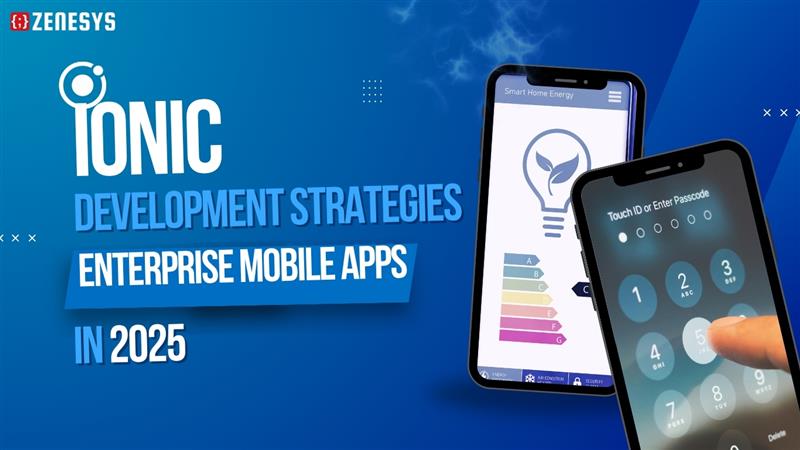Building enterprise mobile apps in 2025 isn’t just about speed or design anymore — it’s about consistency, security, and adaptability. And that’s exactly what Ionic brings to the table.
According to Stack Overflow’s Survey, About 3.5% of professional developers use Ionic, comparable to its market share among other frameworks.
This rise is fueled by global shifts toward mixed-device ecosystems, faster release cycles, and the growing pressure to reduce development costs.
The data tells us one thing clearly — enterprises want more flexibility without starting from scratch every time.
So, how do successful development teams use Ionic today to stay ahead?
Let’s explore the strategies that make Ionic the smart choice for enterprise app development in 2025.
Key Takeaway
Ionic is not just a hybrid framework anymore. With Stable APIs, Capacitor integrations, and real-time cloud builds, it’s now a complete ecosystem for scalable, enterprise-ready apps. Businesses adopting structured Ionic strategies enjoy faster deployments, unified codebases, and lower maintenance costs compared to native-only projects.
Why Ionic Still Matters for Enterprises in 2025
Enterprises have complex needs. They want mobile apps that scale across teams, devices, and regions. Traditional native development often fails to keep up because maintaining separate iOS and Android codebases doubles the workload.
Ionic solves that problem elegantly.
It lets developers create one shared codebase that runs anywhere — browsers, Android, or iOS. The result? Development time shrinks, updates roll out faster, and teams stay more aligned.
In 2025, enterprise developers are also focused on security compliance and integration with corporate tools like Microsoft 365, Salesforce, and legacy ERP systems. Ionic, powered by Capacitor plugins and enterprise SDKs, makes those integrations smoother than ever.
And that’s where a trusted Ionic Development Company can help — by designing scalable frameworks that align with your company’s tech stack and long-term goals.
The Enterprise Shift Toward Hybrid Development
Hybrid development is no longer optional. It’s a strategic move.
Ionic, React Native, and Flutter lead this category, but Ionic stands out for enterprise use.
Why?
Because it uses web technologies — HTML, CSS, and JavaScript — that enterprise teams already know. That means less retraining, faster onboarding, and reduced hiring friction.
But Ionic isn’t just about writing one codebase. It’s about maintaining enterprise-grade stability through proven tools like Ionic CLI, Capacitor, Appflow, and native APIs.
Key Benefits of Ionic for Enterprise App Development
- Faster Deployment: Single codebase updates deploy across all devices.
- Cost Efficiency: Shared components reduce duplication of effort.
- Consistent UI: Ionic UI components ensure brand consistency across apps.
- Scalability: Works effectively with cloud infrastructure like AWS or Azure.
- Security Standards: Supports biometric authentication, OAuth2, and secure storage.
Each benefit addresses a real enterprise pain point — saving time while improving user experience.
Modern Ionic Development Strategies That Work in 2025
Now let’s break down what actually works when developing large-scale enterprise apps using Ionic today.
1. Adopt a Modular Architecture
Think of your app like a building. Instead of one giant block of code, it’s split into reusable modules.
This modular structure makes updates faster and reduces error risks. Each module can be handled by different teams — whether it’s authentication, analytics, or notifications.
It’s also easier to test and deploy independently. This is crucial for large organizations that release frequent updates.
2. Integrate Capacitor for Native Performance
Capacitor is Ionic’s native runtime. It bridges the power of web apps with native device APIs.
Enterprises benefit from Capacitor because it eliminates heavy plugin dependency issues common with older Cordova projects. Developers can access native features like Bluetooth, file storage, geolocation, and push notifications — all within web-based code.
When performance and reliability matter at scale, Capacitor is non-negotiable.
3. Use Appflow for Continuous Delivery
Appflow is the cloud-based build and deployment platform built by Ionic. It simplifies the CI/CD pipeline, ensuring your app updates reach users quickly and safely.
Developers can push updates directly to users without going through app stores every time. That’s a big win for internal enterprise apps that require frequent version changes.
Plus, you can automate builds, run tests in real time, and track deployment analytics — all within one environment.
4. Employ Design Systems for Consistency
A well-defined design system keeps enterprise UI unified. Ionic’s UI toolkit offers ready-made components that can be styled using your corporate design language.
Creating a shared design system ensures brand identity stays consistent across multiple departments and regions. It also reduces time spent reinventing UI patterns repeatedly.
In 2025, this approach aligns closely with accessibility and responsive design standards across devices.
5. Strengthen App Security from the Start
Enterprise apps handle sensitive business data. That’s why Ionic’s security capabilities matter more than ever.
Developers should use encrypted storage plugins, secure authentication flows, and cloud-based monitoring for access control. Adding multi-factor authentication and using trusted SSL certificates keeps vulnerabilities in check.
Security audits and penetration tests before go-live are standard practice. Treating these as part of early development phases prevents future risks.
6. Focus on Performance Optimization
Speed matters — especially for enterprise users who multitask across apps daily.
Use lazy loading to reduce startup time. Compress images. Monitor runtime performance through tools integrated with Capacitor or Chrome DevTools.
Caching common assets offline improves user experience even when connectivity drops. Smooth transitions and low input lag enhance user trust in the app.
It’s all about creating a native-like smooth experience while using web technologies.
7. Plan for Offline and Sync Capabilities
Enterprise apps often operate in field conditions — warehouses, remote sites, or low-internet zones.
Ionic apps can include offline caching mechanisms using Service Workers and background sync techniques. Data updates automatically once a network reconnects, preventing data loss.
It’s a small design choice that creates major value for mobile workforce management apps.
8. Leverage Progressive Web App (PWA) Features
PWAs make Ionic shine on desktops and browsers. For enterprises that want both a mobile app and a web portal, this dual nature is ideal.
Adding install prompts, background sync, and offline caching to PWAs expands reach while cutting down separate web development efforts.
By 2025, most organizations that choose Ionic are rolling out PWAs as part of their main mobile strategy.
9. Enable Enterprise Integrations through APIs
APIs are the glue holding modern enterprises together.
Ionic apps can easily connect to RESTful APIs, GraphQL endpoints, or enterprise middleware systems. Integration with Single Sign-On (SSO), CRMs, and data services ensures smooth workflows.
API-first design isn’t just a developer convenience — it’s a business requirement now.
10. Implement Analytics and Monitoring
Smart enterprises track every user interaction.
By connecting Ionic apps with analytics platforms like Firebase, Amplitude, or custom dashboards, developers can log usage, crashes, and engagement metrics.
Monitoring tools detect issues early and help improve user satisfaction. Data-led iteration is one of the strongest Ionic development practices in 2025.
Future Trends Shaping Ionic Development
The next phase of Ionic development includes several exciting shifts:
- AI-assisted code generation inside IDEs improves developer efficiency.
- Voice interfaces and gesture controls are coming to enterprise apps.
- Low-code integrations within Ionic make non-developers part of the process.
- 5G support and edge computing enhance app responsiveness.
- Enhanced WebAssembly support enables near-native speed for complex enterprise tasks.
These trends will continue to shape how enterprises use Ionic to stay productive and competitive.
How Enterprises Can Future-Proof Their Ionic Apps
Want your Ionic app to last five years or more?
Keep frameworks updated. Use version control practices wisely. Archive or refactor outdated plugins. Automate test suites for each module.
Collaboration tools like Azure DevOps, GitHub Actions, or Bitbucket Pipelines ensure code remains traceable, testable, and maintainable.
Enterprises that plan app lifecycles from day one spend less later fixing outdated components.
Building Scalable Teams Around Ionic
Successful enterprise apps aren’t made by lone developers — they’re built by structured teams.
Forming Ionic-specific squads with clear ownership areas like backend, UI/UX, and testing leads to predictable delivery. Shared documentation and clean code principles improve collaboration across sprints.
In 2025, many enterprise teams are hiring hybrid developers — those who know both web and mobile — to maintain their Ionic-based ecosystem more efficiently.
Why Ionic Fits Modern Enterprise Culture
The reason is simple. It aligns with agility.
Enterprises today value quick pivots, reusable assets, and consistent experiences across roles and devices. Ionic enables that agility through shared tech, shared components, and repeatable CI/CD processes.
It’s web-native thinking meeting mobile practicality.
And that’s exactly what enterprises need in 2025.
Final Thoughts
As business mobility keeps expanding, enterprises need development frameworks that adapt — not just evolve with trends.
Ionic provides that adaptability.
From shared codebases to native integrations and strong deployment pipelines, Ionic development strategies are shaping how enterprises approach mobile creation in 2025.
If your organization wants to build future-ready, scalable, and secure apps — Ionic is a name you can rely on.



